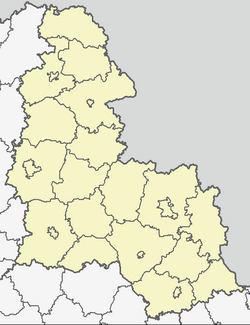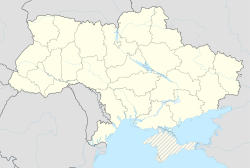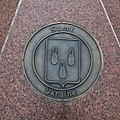Sumy
[dummy-text]
Sumy
Jump to navigation
Jump to search
Sumy Суми | |||
|---|---|---|---|
 Ukrainian Academy of Banking in Sumy | |||
| |||
 Sumy Show map of Sumy Oblast  Sumy Show map of Ukraine | |||
| Coordinates: 50°55′N 34°45′E / 50.917°N 34.750°E / 50.917; 34.750Coordinates: 50°55′N 34°45′E / 50.917°N 34.750°E / 50.917; 34.750 | |||
| Country | |||
| Oblast | Sumy Oblast | ||
| Municipality | Sumy | ||
| Founded | 1655 | ||
| Urban districts | List
| ||
| Government | |||
| • Mayor | Oleksandr Lysenko (Batkivshchyna)[1] | ||
| Area | |||
| • Total | 145 km2 (56 sq mi) | ||
| Population (2015) | |||
| • Total | 267,633 | ||
| • Density | 1,800/km2 (4,800/sq mi) | ||
| Time zone | UTC+2 (CET) | ||
| • Summer (DST) | UTC+3 (CEST) | ||
| Postal code | 40000-40035 | ||
| Area code(s) | +380 542 | ||
| Twinned with | Celle | ||
| Twinned with | Vratsa | ||
| Website | http://www.meria.sumy.ua | ||
Sumy (Ukrainian: Суми [ˈsumɪ], Russian: Сумы [ˈsumɨ]) is a city in north-eastern Ukraine, and the capital of Sumy Oblast (region). Sumy also serves as the administrative center of Sumy Raion of Sumy oblast. Sumy is administratively incorporated as a city of oblast significance and does not belong to the raion. Population: 267,633 (2015 est.)[2]
Contents
1 History
2 Geography
3 Government
4 Demographics
5 Economy and infrastructure
5.1 Enterprises
5.2 Infrastructure
6 Arts and culture
6.1 Landmarks
6.2 Museums
7 Sports
8 Gallery
9 Famous people from Sumy
10 International relations
10.1 Twin towns — sister cities
11 References
12 External links
History[edit]

Downtown Sumy in 1897

Commemorative coin of Sumy's 350-year history
Sumy was founded by Cossack Herasym Kondratyev from Stavyshche, Bila Tserkva Regiment at the bank of the Psel River (a left tributary of the Dnieper).[3] The date of its foundation is a subject of discussion (in 1652 or 1655).[3] In 1656–58 at the site of Sumyn early settlement under leadership of Muscovite voivode K. Arsenyev, there was built a city-fort that consisted of a fort and a grad (town).[3] In 1670s it was expanded by adding a fortified posad (craftsmen town), after which Sumy became the biggest fortress of Sloboda Ukraine.[3] Since 1658 Sumy was a center of the Sumy Cossack Regiment (military unit and local administrative division).[3] In 1680s around Sumy started to form unfortified suburbs.[3]
At the end of 17th century Sumy played a role of collection point of Muscovite troops during the Crimean campaigns of 1687 and 1689.[3] During the Great Northern War (1700–1721) in December 1708 – January 1709 in the city was located Stavka (headquarters) of Muscovite Chief of Commander headed by Tsar Peter the Great.[3] Established under the leadership of Prince A.Shakhovskoy, in 1734-43 in Sumy was located the Commission on streamlining the Sloboda Cossack regiments.[3] From its establishment and until the liquidation of Cossackdom in Sloboda Ukraine in 1765, the Cossack officer family of Kondratyevs had a great influence over the city.[3]
Following the liquidation of Cossack community in 1765, Sumy Cossack Regiment as an administrative division was turned into Sumy Province of the newly created Sloboda Ukraine Governorate and the city of Sumy became its center.[3] In 1780 Sumy was turned into a county (uyezd) seat.[3] In 1786-89 the city was reformed by removing its city fort vallums.[3] After a period of stagnation (1765–1860s), Sumy began to transform into a big industrial and trade center with the Paul's Sugar-Refining Factory (est. 1869 by I.Kharytonenko) and the Sumy Engineering Workshops (est. 1896, producing equipment for sugar refineries).[3] With the construction of a railroad Vorozhba – Merefa, in January 1877 in the city was built the Sumy train station.[3] A great contribution in development of Sumy made various families of philanthropists industrialists, the most famous of which are Kharytonenkos.[3]
During the Revolution of 1905, Sumy was one of several areas which became famous throughout Russia for in effect having established an independent peasant republic; the Sumy Republic was established by a peasant union.[4]
During the German occupation of Ukraine during World War II (1941 – 1944), Sumy sustained heavy damage. Sumy was occupied from October 10, 1941 to September 2, 1943. After the war, the destroyed parts of the city were built anew. Sumy has been a twin town of Celle, Germany since January 17, 1990.
Geography[edit]
Sumy is located in the northeastern part of Ukraine within the Central Russian Upland and in historical region of Sloboda Ukraine. It is located on the banks of Psel River.
Due to its relatively close location, the city's weather is similar to Kharkiv. Sumy's climate is a humid continental one: cold and snowy winters, and hot summers. The seasonal average temperatures are not too cold in winter, not too hot in summer: −6.9 °C (19.6 °F) in January, and 20.3 °C (68.5 °F) in July. The average rainfall totals 513 mm (20 in) per year, with the most in June and July.
| Climate data for Sumy, Ukraine (1949-2011) | |||||||||||||
|---|---|---|---|---|---|---|---|---|---|---|---|---|---|
| Month | Jan | Feb | Mar | Apr | May | Jun | Jul | Aug | Sep | Oct | Nov | Dec | Year |
| Record high °C (°F) | 11.0 (51.8) | 13.5 (56.3) | 21.0 (69.8) | 30.0 (86.0) | 33.6 (92.5) | 36.1 (97.0) | 38.0 (100.4) | 39.4 (102.9) | 31.1 (88.0) | 27.9 (82.2) | 22.8 (73.0) | 11.5 (52.7) | 39.4 (102.9) |
| Average high °C (°F) | −3.9 (25.0) | −3.0 (26.6) | 3.0 (37.4) | 13.1 (55.6) | 20.3 (68.5) | 23.7 (74.7) | 25.4 (77.7) | 24.5 (76.1) | 18.3 (64.9) | 10.9 (51.6) | 3.0 (37.4) | −2.0 (28.4) | 11.2 (52.2) |
| Daily mean °C (°F) | −6.3 (20.7) | −5.9 (21.4) | −0.7 (30.7) | 8.1 (46.6) | 14.6 (58.3) | 18.1 (64.6) | 19.8 (67.6) | 18.6 (65.5) | 12.9 (55.2) | 6.6 (43.9) | 0.3 (32.5) | −4.2 (24.4) | 6.8 (44.2) |
| Average low °C (°F) | −9.3 (15.3) | −9.2 (15.4) | −4.2 (24.4) | 3.3 (37.9) | 8.8 (47.8) | 12.6 (54.7) | 14.5 (58.1) | 13.1 (55.6) | 8.0 (46.4) | 2.8 (37.0) | −2.3 (27.9) | −6.8 (19.8) | 2.6 (36.7) |
| Record low °C (°F) | −34.2 (−29.6) | −32.8 (−27.0) | −27.8 (−18.0) | −11.1 (12.0) | −3.9 (25.0) | 0.9 (33.6) | 5.0 (41.0) | 4.0 (39.2) | −4.3 (24.3) | −11.7 (10.9) | −22.9 (−9.2) | −29.5 (−21.1) | −34.2 (−29.6) |
| Average precipitation mm (inches) | 55.5 (2.19) | 32.9 (1.30) | 47.1 (1.85) | 46.9 (1.85) | 61.9 (2.44) | 69.9 (2.75) | 81.3 (3.20) | 87.4 (3.44) | 49.6 (1.95) | 48.2 (1.90) | 43.8 (1.72) | 50.9 (2.00) | 675.4 (26.59) |
| Average precipitation days | 20.7 | 18.4 | 15.7 | 9.9 | 9.2 | 8.7 | 7.1 | 5.7 | 8.9 | 11.9 | 16.2 | 21.1 | 153.5 |
| Average snowy days | 18 | 14 | 10 | 3 | 0 | 0 | 0 | 0 | 0 | 2 | 10 | 17 | 74 |
| Average relative humidity (%) | 86.4 | 84.3 | 79.3 | 65.6 | 64.0 | 68.1 | 70.9 | 66.6 | 75.1 | 81.0 | 87.2 | 88.5 | 76.4 |
| Source #1: Climatebase.ru[5] | |||||||||||||
| Source #2: Weatherbase[6] | |||||||||||||
Government[edit]
Sumy is a city of oblast significance which makes a separate subdivision within the Sumy Oblast. Sumy is also an administrative center of Sumy Raion which surrounds the city.
The city used to be divided into two urban raions (districts), Zarichny and Kovpakovsky, and 13 micro-raions. Since 2006, the subdivision into urban districts is not in effect.[7]
The city municipality also includes several adjacent villages including Verkhnie Pishchane, Zhyteiske, Zahirske, Kyryiakivshchyna, Pishchane, and Trokhymenkove.
Demographics[edit]

Demographics of Sumy
| Historical population | ||
|---|---|---|
| Year | Pop. | ±% |
| 1850 | 11,500 | — |
| 1897 | 27,564 | +139.7% |
| 1913 | 50,400 | +82.8% |
| 1926 | 44,000 | −12.7% |
| 1939 | 69,000 | +56.8% |
| 1959 | 98,000 | +42.0% |
| 1970 | 159,000 | +62.2% |
| 1979 | 231,558 | +45.6% |
| 1989 | 293,706 | +26.8% |
| 2001 | 295,847 | +0.7% |
| [citation needed] | ||
- 1897 - 70.53% Ukrainians, 24.1% Russians, 2.6% Jewish, 2.67% others
- 1926 - 80.7% Ukrainians, 11.8% Russians, 5.5% Jewish, 2% others
- 1959 - 79% Ukrainians, 20% Russians, 1% others[citation needed]
The majority of residents are Christians (Eastern Orthodox, Roman Catholics and Protestant or Evangelical Christians). There is also a Jewish minority.
From the beginning of the twentieth century, Sumy was the center of Roman Catholicism in the northeastern Ukraine. The Blessed Virgin Mary Annunciation Church was established in the city in 1901 and consecrated in 1911, but closed by governmental authorities two decades later; the churchhouse was thereafter used for non-religious purposes (e.g., it was used as a gym for Oleksandrivska Gymnasia) until its restoration as a Roman Catholic parish in May 1994, after the disintegration of the Soviet Union. It was reconsecrated in the Spring of 1998.
Economy and infrastructure[edit]
Enterprises[edit]
- Sumy Engineering Science and Production Association (formerly Frunze factory)
- Sumykhimprom, a major chemical factory
- Chervonozoryanyi Sugar-refining Factory
- others
Infrastructure[edit]

Sumy train station
- The city has Sumy Airport. Built in 1978, since 2006 it was turn into international airport and able to .
- There are several train stations in the city, two of which serve passenger trains. All train stations are part of the UZ regional branch Southern Railways. Sumy train station also is headquarters of one of four territorial subdivisions of the Southern Railways and conducts supervision over some other 45 train stations in Sumy, Poltava, and Kharkiv oblasts.
- There are two major routes that cross the city H07 (Kiev–Yunakivka at Russian border) and H12 (Sumy–Poltava). There are also few regional routes P44 (Sumy–Hlukhiv), P45 (Sumy–Bohodukhiv), and P61 (Sumy–Baturyn).
Arts and culture[edit]
Landmarks[edit]

Psel river in Sumy
- The city centre is dominated by the large cathedral of the Saviour's Transfiguration. It is a neoclassical structure of the 18th century, extensively repaired and reconstructed in 1858 and in the 1880s, when the 56 metre (180 ft) high bell tower was added. The interior features frescoes by Vladimir Makovsky and Klavdiy Lebedev.
- The Resurrection Church (1702), the oldest structure in the town, is still in fair preservation, owing to recent restoration work.
- The cathedral of the monastery of St. Pantaleon was erected in 1911 to a design by Aleksey Shchusev and is scored to resemble medieval monuments of Novgorod and Pskov.
- A lovely church of Saints Peter and Paul is in the town's cemetery. It was built in 1851 on the donations of Sumy citizens. Beside the church there are tombs of the Kharytonenkos and Sukhanovs with artistic monuments by the famous sculptors – A. Croisy and M. Antokolski.
- The Cathedral of Holy Trinity was built in 1902-1914 on the same pattern as the Cathedral of St. Isaac in St. Petersburg. The author of the design was Sumy architect G. Sholts. It was built at the expense of Pavlo Kharitonenko, the local manufacturer and Maecenas who fulfilled his father's last will. Icon-painting is by famous artist M. Nesterov. The work on the decorative design was not completed because of the revolutionary events of 1917.
Museums[edit]
The Sumy Regional Art Museum was opened in 1920. It was started from nationalized private collections of the town and district. Paintings of Taras Shevchenko, Vladimir Borovikovsky, I. Shyskin, Arkhip Kuindzhi and Tetyana Yablonska are on display, including a Dutch landscape by a painter of Jan van Goyen's circle. Today the museum contains unique paintings and works of applied art. The building of the early 20th century originally belonged to the State Bank.
The Museum of Local Lore was opened in 1920. In the years of fascist occupation the most important items of its collections were lost. Today it contains unique collections covering archeology and natural history of the Sumy region. It is located in the building of the 19th century which originally was the seat of the district government. In 1905 it was given to the printing house and publishing house of the first Sumy newspapers. In different years the building was visited by A. Kuprin and V. Korolenko, the famous Russian writers.
The Chekhov Museum, located in Chekhov street is an architectural complex representing Lintvarev's country estate of the 18th and 19th centuries. In 1888 and 1889 a great writer and dramatist Anton Chekhov was dreaming to settle in Luka forever but his dream did not come true. “Abbacia and the Adriatic Sea are wonderful, but Luka and Psiol are better” – he wrote in his letter from Italy to his friends in Sumy in 1894. This is also a place where Anton Chekhov's brother, Nikolai Chekhov, died in 1889.
The Museum of Banking history in the Sumy oblast and the History of Ukrainian Money was founded in 2006 to commemorate the 10th anniversary of the Ukrainian Academy of Banking on the basis of a unique collection of Ukrainian bonds – the paper money out of circulation, which were given to the academy by the National Bank of Ukraine. The exposition of the bonds is arranged in the thematic-chronological order - from the first appearance of money to the present day. In addition to the numerous historical documents, photographs, metal money (coins, souvenir bars), and commemorative medals of the National Bank of Ukraine, there is an exhibition presenting technical appliances used in the banking industry in the late 20th century.
Sports[edit]

Yuvileiny Stadium
Sumy is home to the Ukrainian First League football team FC Sumy.
The Ukrainian Premier League football club FC Kharkiv were leasing the city's state-of-the-art Yuvileiny Stadium.
The Yuvileiny Stadium, formerly known as Spartak, was planned to be renovated just before dissolution of the Soviet Union and in 1989 was demolished to be built anew. It was not until 1998 when the actual construction was resumed and finally finished in 2002.
Gallery[edit]

Trinity Cathedral

Catholic Church
Elias Church
Altanka

Sumy in spring of 2010

Shopping street in Sumy

City centre

Hotel Shafran

Old architecture in Sumy
Sumy in Winter

An exhibition centre in Sumy

Park in Sumy

"Kyiv" department store

Sumy regional administration
Famous people from Sumy[edit]
Karl Burman (1882–1965), Estonian architect; was born in Sumy
Oleh Husyev (born 1983), Ukrainian football player
Bogdan Titomir[citation needed] (born 1967), Russian musician, rapper and DJ
Viktor Yushchenko (born 1954), President of Ukraine
Valj Semerenko (born 1986), Ukrainian biathlete
Vita Semerenko (born 1986), Ukrainian biathlete
Volodymyr Holubnychy (born 1936), legendary race-walker, 4-time Olympic medalist
Oleksiy Alchevsky, Ukrainian industrialist and philanthropist, founder of the city of Alchevsk
Mykola Hrunskyi, a senior researcher specializing in studying of the Russian language in the Linguistic Institute of the National Academy of Sciences of Ukraine
Yekaterina Pavlovna Volzhina Peshkova (born 1876), a Soviet human rights activist and humanitarian, first wife of Maxim Gorky.
International relations[edit]
Twin towns — sister cities[edit]
Sumy is twinned with:
Current:
|
Former:[10]
|
References[edit]
- Notes
^ "Archived copy". Archived from the original on 2014-05-31. Retrieved 2014-06-25.CS1 maint: Archived copy as title (link).mw-parser-output cite.citationfont-style:inherit.mw-parser-output .citation qquotes:"""""""'""'".mw-parser-output .citation .cs1-lock-free abackground:url("//upload.wikimedia.org/wikipedia/commons/thumb/6/65/Lock-green.svg/9px-Lock-green.svg.png")no-repeat;background-position:right .1em center.mw-parser-output .citation .cs1-lock-limited a,.mw-parser-output .citation .cs1-lock-registration abackground:url("//upload.wikimedia.org/wikipedia/commons/thumb/d/d6/Lock-gray-alt-2.svg/9px-Lock-gray-alt-2.svg.png")no-repeat;background-position:right .1em center.mw-parser-output .citation .cs1-lock-subscription abackground:url("//upload.wikimedia.org/wikipedia/commons/thumb/a/aa/Lock-red-alt-2.svg/9px-Lock-red-alt-2.svg.png")no-repeat;background-position:right .1em center.mw-parser-output .cs1-subscription,.mw-parser-output .cs1-registrationcolor:#555.mw-parser-output .cs1-subscription span,.mw-parser-output .cs1-registration spanborder-bottom:1px dotted;cursor:help.mw-parser-output .cs1-ws-icon abackground:url("//upload.wikimedia.org/wikipedia/commons/thumb/4/4c/Wikisource-logo.svg/12px-Wikisource-logo.svg.png")no-repeat;background-position:right .1em center.mw-parser-output code.cs1-codecolor:inherit;background:inherit;border:inherit;padding:inherit.mw-parser-output .cs1-hidden-errordisplay:none;font-size:100%.mw-parser-output .cs1-visible-errorfont-size:100%.mw-parser-output .cs1-maintdisplay:none;color:#33aa33;margin-left:0.3em.mw-parser-output .cs1-subscription,.mw-parser-output .cs1-registration,.mw-parser-output .cs1-formatfont-size:95%.mw-parser-output .cs1-kern-left,.mw-parser-output .cs1-kern-wl-leftpadding-left:0.2em.mw-parser-output .cs1-kern-right,.mw-parser-output .cs1-kern-wl-rightpadding-right:0.2em
http://www.pravda.com.ua/news/2014/05/29/7027390/
^ "Чисельність наявного населення України (Actual population of Ukraine)" (PDF) (in Ukrainian). State Statistics Service of Ukraine. Retrieved 1 July 2016.
^ abcdefghijklmnop Bazhan, O.H., Vortman, D.Ya., Masliychuk, V.L. Sumy, regional center (СУМИ, ОБЛАСНИЙ ЦЕНТР). Encyclopedia of History of Ukraine.
^ Figes, Orlando: A People's Tragedy: The Russian Revolution 1891–1924. The Bodley Head, London (2014). p. 183
^
"Sumy, Ukraine Climate Data". Climatebase. Retrieved January 21, 2013.
^ "Weatherbase: Historical Weather for Sumy, Ukraine". Weatherbase. Retrieved January 21, 2013.
^ Verkhovna Rada website
^ "Stadt Celle". www.celle.de. Retrieved 2010-01-05.
^ "Miasta Partnerskie Lublina" [Lublin - Partnership Cities]. Urząd Miasta Lublin [City of Lublin] (in Polish). Archived from the original on 2013-01-16. Retrieved 2013-08-07. External link in|work=(help)
^ "Суми розірвали побратимські відносини з російськими містами". Zaxid.net. Retrieved 2017-11-24.
External links[edit]
| Wikimedia Commons has media related to Sumy. |
| Wikivoyage has a travel guide for Sumy. |
| Look up sumy in Wiktionary, the free dictionary. |
(in English)(in Ukrainian)(in Russian) City of Sumy travel guide
(in Ukrainian) Independent regional Web-portal - news, features, entertainment & tourism info
(in Ukrainian) Sumy administration
(in English) Sumy travel guide- Medical institute of Sumy State University
- The Sumian Historical Web-Society
(in Ukrainian) Regional Web-portal, open business-directory of the city- Portal Sumy - news, weather, calendar, map, ad
(in English) City centre Web-cam
Categories:
- Sumy
- Cities in Sumy Oblast
- Kharkov Governorate
- Populated places established in 1652
- Cities of regional significance in Ukraine
- 1652 establishments in Russia
- Oblast centers in Ukraine
- Cities and towns built in the Sloboda Ukraine
(window.RLQ=window.RLQ||).push(function()mw.config.set("wgPageParseReport":"limitreport":"cputime":"1.144","walltime":"1.727","ppvisitednodes":"value":7510,"limit":1000000,"ppgeneratednodes":"value":0,"limit":1500000,"postexpandincludesize":"value":146880,"limit":2097152,"templateargumentsize":"value":15964,"limit":2097152,"expansiondepth":"value":25,"limit":40,"expensivefunctioncount":"value":10,"limit":500,"unstrip-depth":"value":1,"limit":20,"unstrip-size":"value":44016,"limit":5000000,"entityaccesscount":"value":1,"limit":400,"timingprofile":["100.00% 1451.979 1 -total"," 31.14% 452.169 1 Template:Infobox_settlement"," 21.01% 305.064 1 Template:Infobox"," 14.47% 210.044 1 Template:Reflist"," 11.80% 171.380 7 Template:Cite_web"," 9.53% 138.347 1 Template:Lang-uk"," 6.68% 97.008 3 Template:Citation_needed"," 5.96% 86.561 3 Template:Fix"," 4.87% 70.697 1 Template:Historical_populations"," 4.77% 69.284 10 Template:Flagicon"],"scribunto":"limitreport-timeusage":"value":"0.517","limit":"10.000","limitreport-memusage":"value":18656628,"limit":52428800,"cachereport":"origin":"mw1274","timestamp":"20190322080333","ttl":2592000,"transientcontent":false);mw.config.set("wgBackendResponseTime":130,"wgHostname":"mw1270"););


















